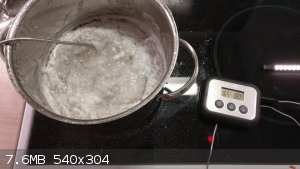I committed a small test with CaCl2 due to having a kg of it right on hand. I mixed about 500mL of water into 1kg of anhydrite and boiled it until all
granulates were dissolved.
I managed to initially get it up to 175C, but a large amount of solids were present, but it would be very usable as a heating bath anyway. At 165C a
crust keeps forming on top, but the liquor is in fully liquid form beneath it. Less heating will make it still, and little to no evaporation occurs,
hence it could be kept as such for hours to go. I used my CaCl2 bath to distill ethanol for 8 hours straight, and it only lost few mm of depth due to
evaporation.
A preparation for high temp bath would be best done in such way that first a fully liquid solution is made, and then more CaCl2 is gradually added
while boiling, until desired temp is achieved.
The downside with high temp CaCl2 bath appears to be that it turns into porridge while still way above 100C and it solidifies probably before cooling
below that, so high temp bath should be either produced from ground CaCl2 hydrate into which the reaction vessel is immersed and gradually heated, or
as above, preparing first a less concentrated bath up to ~50% that remains liquid at safe temps to immerse a flask, and then add more CaCl2 to bring
the temp up. For lower temp baths a lower concentration solution can be used as such.
CaCl2 works as dual-use material because it remains liquid with good viscosity down to -35C(tested) and all the way to -50C in +30% concentrations.
The viscosity resembles cooking oil. It appears to be an excellent coolant for it's temp range.
It is practically odorless, but it has a very mild, sharp odor within its immediate vicinity, probably owing due to it's extreme hygroscopicity, which
irritates membranes, hence breathing in it's dust feels quite uncomfortable.
I would consider twice using this type of bath to heat sulfuric acid or other acids or substances that could react readily with chloride. A flask full
of concentrated sulfuric acid breaking at 180C while being immersed in concentrated CaCl2 liquid would cause instant release of huge, most likely
lethal amount of HCl gas, and probably also splattering of burning hot, corrosive and toxic mixture of chloride, acid and HCl.
A major benefit of CaCl2 is it's very low price, being sold as road salt, usually in 77% hydrate granular form. A 25kg bag tends to cost between 10
and 20 bucks, depending on vendor.

[Edited on 7-7-2020 by Refinery]
|